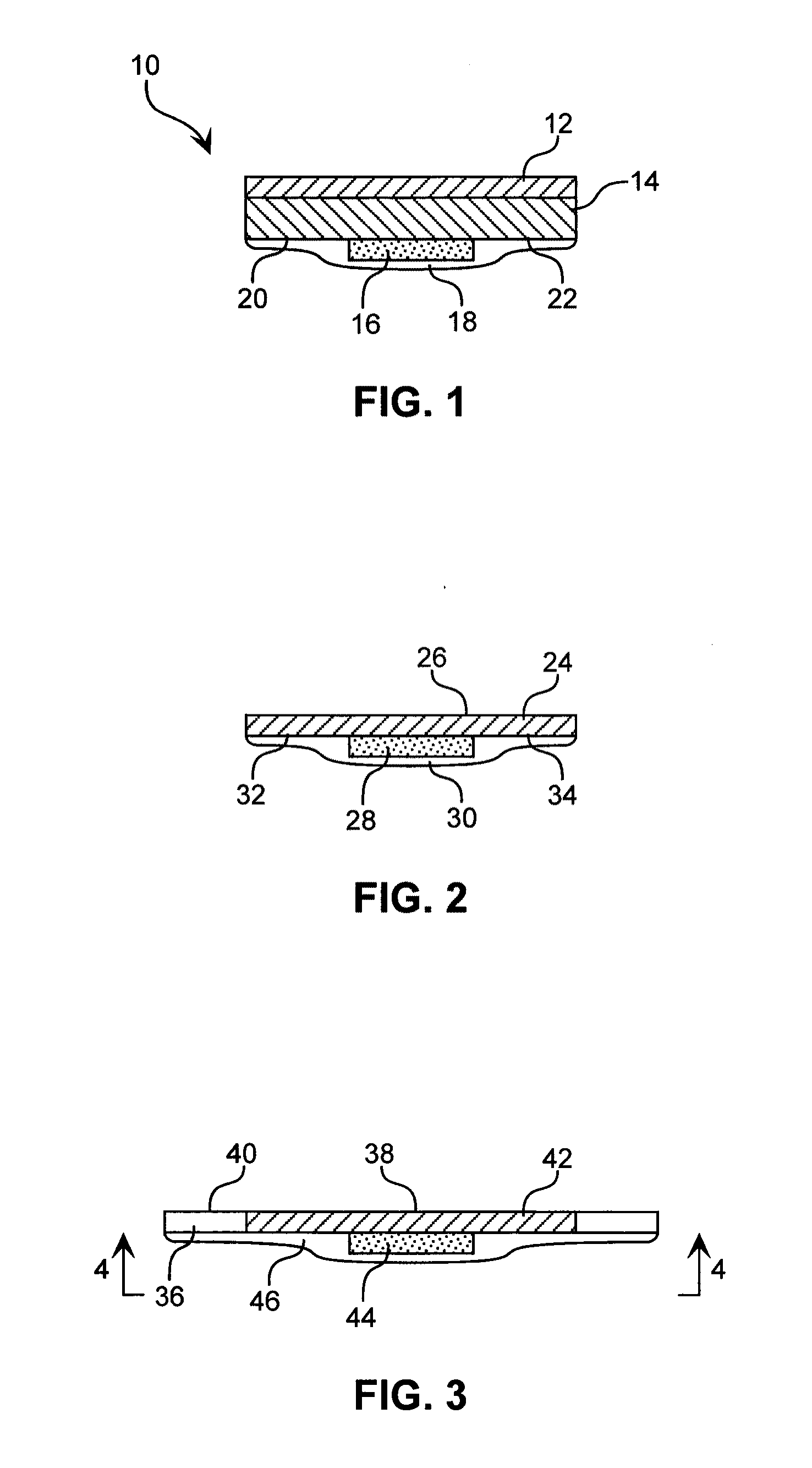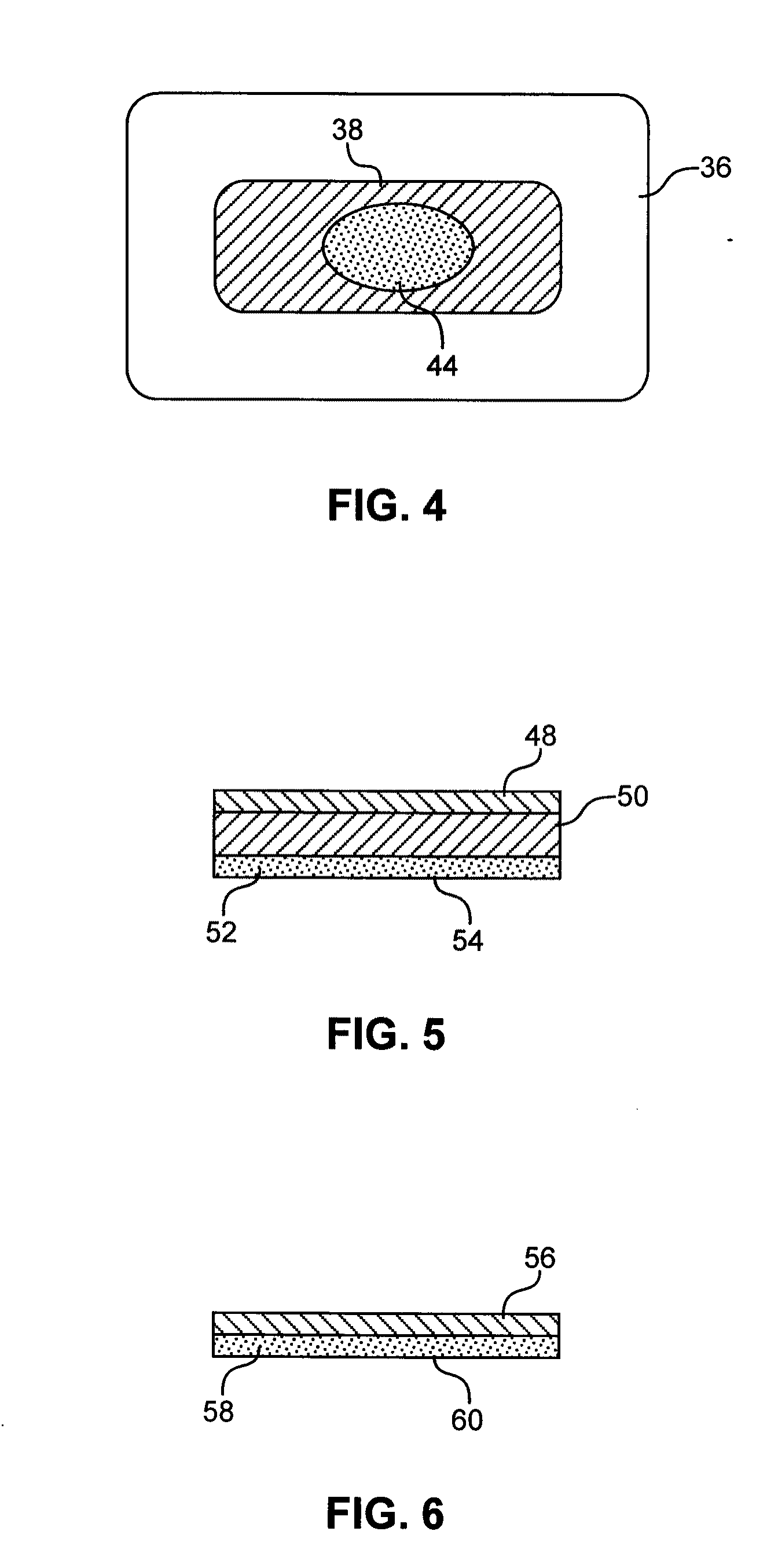Hydrogel Compositions
a technology of compositions and hydrogels, applied in the field of hydrogel compositions, can solve the problems of limited absorbance of these materials, wound injury upon removal, and use of adhesives, and achieve the effects of optimizing the effects of adhesion, absorption, translucence, and swelling
- Summary
- Abstract
- Description
- Claims
- Application Information
AI Technical Summary
Benefits of technology
Problems solved by technology
Method used
Image
Examples
example 1
[0185]A hydrogel composition (designated 12SP-39) of a discontinuous hydrophobic phase and a discontinuous hydrophilic phase was prepared containing the following components:
[0186]Hydrophobic Phase:
[0187]Kalar 5246, 9.70 wt. %;
[0188]Styrene plasticizer, 29.12 wt. %;
[0189]SIS Vector 4111, 12.13 wt. %;
[0190]Regalite 1900, 9.70 wt. %;
[0191]Irganox 1010, 0.5 wt. %.
[0192]Hydrophilic Phase:
[0193]Aquasorb A500, 38.84 wt. %.
The above components were melt-processed in a Brabender single screw extruder as follows. The Aquasorb A500 was added to the extruder first, followed by the components of the hydrophobic phase, at a temperature of 130° C. The extruded hydrogel composition was placed onto a polyethylene terephthalate release liner and then pressed using a Carver press.
example 2
[0194]A second hydrogel composition (designated 12SP-38), comprised of a discontinuous hydrophobic phase and a discontinuous hydrophilic phase, was prepared containing the following components, using the melt extrusion process of Example 1:
[0195]Hydrophobic Phase:
[0196]Kalar 5215, 9.70 wt. %;
[0197]Styrene plasticizer, 29.12 wt. %;
[0198]SIS Vector 4111, 12.13 wt. %;
[0199]Regalite 1900, 9.70 wt. %;
[0200]Irganox 1010, 0.5 wt. %.
[0201]Hydrophilic Phase:
[0202]Aquasorb A500, 38.84 wt. %.
[0203]Examples 3 and 4 describe preparation of hydrogel compositions composed of a discontinuous hydrophobic phase and a continuous hydrophilic phase using melt extrusion.
example 3
[0204]A hydrogel composition (designated 12SP-42) comprised of a discontinuous hydrophobic phase and a continuous hydrophilic phase was prepared containing the following components:
[0205]Hydrophobic Phase:
[0206]Kalar 5246, 7.9 wt. %;
[0207]Styrene plasticizer, 23.70 wt. %;
[0208]SIS Vector 4111, 9.86 wt. %;
[0209]Regalite 1900, 7.90 wt. %;
[0210]Irganox 1010, 0.5 wt. %.
[0211]Hydrophilic Phase:
[0212]DOA, 3.94 wt. %;
[0213]CAB 551-0.2, 7.90 wt. %;
[0214]PVP / PEG 400, 38.35 wt. %.
[0215]The above components were melt-processed in a Brabender single screw extruder as follows. The CAB 551-0.2 and half of the PEG 400 were added to the extruder first, at a temperature of 140° C. Then, the PVP, the DOA, and the remaining PEG 400 were added at a temperature of 140° C. The extruded hydrogel composition was placed onto a polyethylene terephthalate (PET) release liner and then pressed using a Carver press.
PUM
| Property | Measurement | Unit |
|---|---|---|
| Fraction | aaaaa | aaaaa |
| Fraction | aaaaa | aaaaa |
| Fraction | aaaaa | aaaaa |
Abstract
Description
Claims
Application Information
 Login to View More
Login to View More - R&D
- Intellectual Property
- Life Sciences
- Materials
- Tech Scout
- Unparalleled Data Quality
- Higher Quality Content
- 60% Fewer Hallucinations
Browse by: Latest US Patents, China's latest patents, Technical Efficacy Thesaurus, Application Domain, Technology Topic, Popular Technical Reports.
© 2025 PatSnap. All rights reserved.Legal|Privacy policy|Modern Slavery Act Transparency Statement|Sitemap|About US| Contact US: help@patsnap.com



